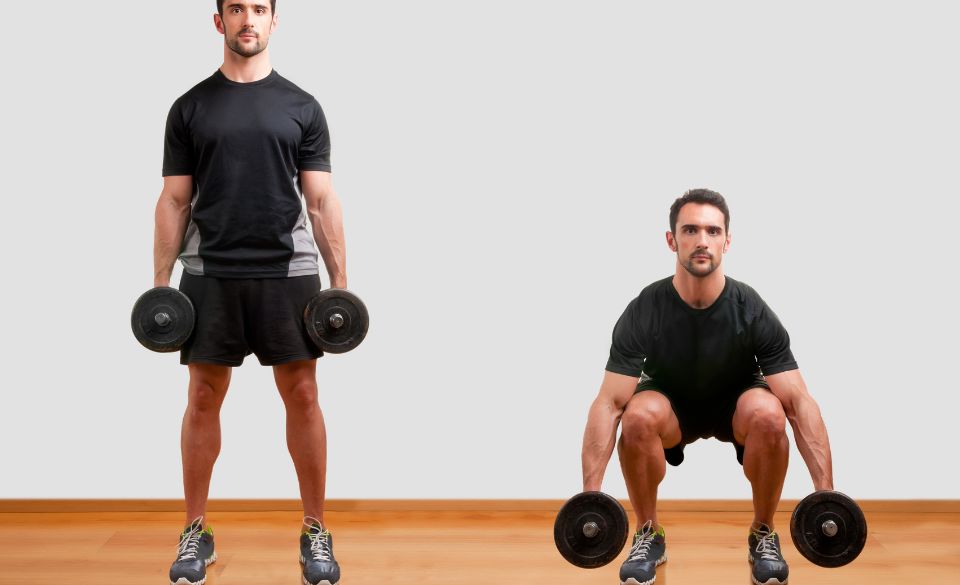
Squatting With Dumbbells – What Should You Know
Page Contents
Are you looking to switch up your squatting routine? Adding dumbbells to your squat can be a great way to add intensity and variation to your workouts. In this article, we’ll cover how to properly perform a squat with dumbbells, the benefits of this exercise, and whether it’s better to use a barbell or dumbbells for squats.
How To Squat With Dumbbells
Squatting with dumbbells is a great exercise for building lower body strength and muscle mass. Here are some steps to follow to perform a squat with dumbbells:
1. Stand with your feet shoulder-width apart and hold a dumbbell in each hand at your sides.
2. Keep your chest up and your core engaged.
3. Begin by bending your knees and lowering your hips down and back as if you’re sitting in a chair. Make sure your knees stay in line with your toes.
4. Lower your body until your thighs are parallel to the ground or lower, if you can.
5. Push through your heels and straighten your legs to return to the starting position.
6. Repeat for the desired number of reps.
Here are some additional tips to keep in mind when squatting with dumbbells:
– Keep your back straight and your chest up throughout the exercise.
– Don’t let your knees go past your toes.
– Keep your core engaged to help stabilize your body during the exercise.
– Start with a lighter weight and gradually increase the weight as you get stronger.
– Always use proper form and technique to avoid injury and get the most out of the exercise.
By following these steps and tips, you can perform a squat with dumbbells with proper form and technique, and effectively target your lower body muscles for improved strength and muscle mass.
Is Squatting With Dumbbells Effective?
Squatting with dumbbells is an effective exercise for building lower body strength and muscle mass. When you perform a squat with dumbbells, you’re engaging a variety of muscles in your lower body, including your quadriceps, hamstrings, glutes, and calves. This makes dumbbell squats a great all-around exercise for building lower body strength and muscle mass.
In fact, a study published in the Journal of Strength and Conditioning Research found that there were no significant differences in muscle activation or strength gains between barbell squats and dumbbell squats. This suggests that squatting with dumbbells is just as effective as squatting with a barbell.
It’s important to note that the weight you use for dumbbell squats will have an impact on the effectiveness of the exercise. It’s important to choose a weight that challenges you without compromising your form, and to gradually increase the weight as you get stronger.
Overall, squatting with dumbbells is an effective exercise that can help you build lower body strength and muscle mass. By incorporating dumbbell squats into your workout routine, you can target multiple muscle groups and see improvements in your overall lower body strength and muscle definition.
How Heavy Should Dumbbells Be For Squats?
If you’re looking to add squats with dumbbells to your workout routine, you might be wondering how heavy the dumbbells should be. The weight you choose can have a significant impact on the effectiveness of the exercise, and it’s important to choose a weight that challenges you without compromising your form. In this article, we’ll take a closer look at a study that explores how heavy dumbbells should be for squats.
In a study published in the Journal of Strength and Conditioning Research, researchers examined the effects of different resistance levels on muscle activation during dumbbell squats. The study involved 15 healthy, resistance-trained men who performed dumbbell squats with three different loads: 30% of their one-repetition maximum (1RM), 50% of their 1RM, and 70% of their 1RM.
The study found that muscle activation increased as the load increased. Specifically, the researchers found that the quadriceps muscles were most activated during the 70% 1RM condition, while the hamstrings were most activated during the 50% 1RM condition. Interestingly, the study also found that muscle activation was highest during the eccentric (lowering) phase of the squat, rather than the concentric (lifting) phase.
Based on the findings of this study, it’s clear that the weight of the dumbbells you use for squats can have a significant impact on muscle activation. If you’re looking to target your quads, using heavier dumbbells (70% of your 1RM) might be more effective. However, if you’re looking to target your hamstrings, using slightly lighter dumbbells (50% of your 1RM) might be a better option.
When it comes to how heavy dumbbells should be for squats, the answer depends on your fitness level and goals. However, this study provides some valuable insights into the effects of different resistance levels on muscle activation during dumbbell squats. Ultimately, it’s important to choose a weight that challenges you without compromising your form, and to gradually increase the weight as you get stronger.
Is It Better To Squat With A Bar Or Dumbbell?
When it comes to squats, there are a variety of equipment options available, including barbells and dumbbells. Both options have their own unique benefits and drawbacks, but which one is better? In this article, we’ll take a closer look at a study that compares the effectiveness of squats with a barbell versus a dumbbell.
In a study published in the Journal of Strength and Conditioning Research, researchers compared the muscle activation and strength gains between barbell squats and dumbbell squats. The study involved 24 healthy men who were randomly assigned to either a barbell or dumbbell squat group. Both groups performed three sets of 10 repetitions twice a week for eight weeks.
The study found that both barbell squats and dumbbell squats were effective for increasing lower body strength and muscle activation. However, the study also found that barbell squats led to greater activation of the quadriceps muscles, while dumbbell squats led to greater activation of the hamstrings and glutes.
Additionally, the study found that both groups experienced significant improvements in lower body strength, but the barbell squat group had greater improvements in their one-rep max (1RM) squat than the dumbbell squat group.
Based on the findings of this study, it’s clear that both barbell squats and dumbbell squats are effective for building lower body strength and muscle mass. However, the equipment you choose can have an impact on which muscles are most activated.
If you’re looking to target your quads specifically, barbell squats might be a better option. On the other hand, if you’re looking to target your hamstrings and glutes more, dumbbell squats might be the way to go.
Final Words
Squatting with dumbbells can be a great way to add variation and intensity to your lower body workouts. Start with a weight that allows you to maintain good form and gradually increase the weight as you get stronger. Remember that both barbells and dumbbells can be effective for squats, so choose the option that works best for your fitness goals.


